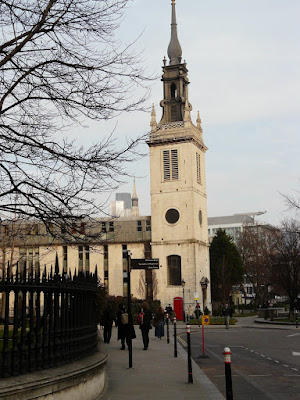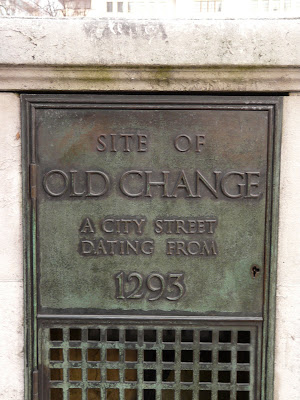I would have some pictures, but no cameras are allowed. I have taken some images off of the interwebs for you. First the history and then a bit about attending service.

When most people think of St. Paul's Cathedral in London the image of Christopher Wren's magnificent classical church rises in their minds, but there was a cathedral dedicated to St. Paul long before the able Mr. Wren put his stamp on the skyline of Stuart London.
The first church on this spot was erected in 604 AD, just 8 short years after the first Christian mission under St. Augustine landed in Kent. This wooden church was established by King Ethelbert of Kent as home to the first bishop of the East Saxons, Mellitus.
That first church was destroyed by fire and rebuilt by St. Erkenwald, then bishop, in 675-85. Fire was not the only danger faced by buildings in those dark centuries of Anglo-Saxon England - the Vikings destroyed the second St. Paul's in 962 during on of their periodic invasions.

Once again, fire destroyed the church in 1087. The new Norman building, now called Old St. Paul's, took over 150 years to complete, the final touches being applied in 1240. Well, not quite final touches - a new Gothic choir was added by 1313, making St. Paul's the third longest church in Europe at 596 feet. The following year the spire was completed. At 489 feet it was the tallest in all Europe.
In the Tudor period an open-air pulpit called Paul's Cross was established by the south wall of St. Paul's. There crowds gathered to hear rabble-rousing Protestant sermons. In 1549 the preachers incited a mob to sack the cathedral itself. They rampaged through the interior, destroying the high altar and ravaging the tombs, wall-hangings, and tombs.
During the English Civil War, Parliamentary troops commandeered the cathedral and used the nave as cavalry barracks. They broke up the scaffolding and sold the material.The fortunes of Old St. Paul's seemed to take a turn for the better with the Restoration of the Monarchy in 1660. Charles II appointed a young architect named Christopher Wren to undertake major repairs to the building. Wren had only begun his work when final calamity struck.

On September 4, 1666, fire broke out in a bakehouse in Pudding Lane. Fanned by a fierce wind, the fire spread through the close-packed streets of London, destroying everything in its path. For four days the fire raged, and when the smoke finally cleared, Old St. Paul's was nothing but charred timbers and rubble.

Inside, the space is huge and echoing. The pillars just vault to the ceiling. It is an odd mix of a church and a museum. However, it is a working church, which is wonderful.

This gives you some sense of what the ceiling looks like. Those are the choir stalls.

There is a bell tower -- an image just for you, Rowan.
So, to get back to the present -- Wry and I walked across the street, tummies full and refreshed, to attend services in St. Paul's Cathedral. There are really no words to express what this experience was like.

This is the shape of the church. We came in the main entrance and ended up sitting under the dome, listening to Evensong.

The church is gorgeous -- really. I think I would like to come back, just to look more closely at it. Every single inch is beautiful. We walked through the rows of chairs and I sat down. Wry kept going, into a roped off area for those who were not just there to observe, but to participate in the service. We got programs that told us what Evensong was going to be for that service.

This is pretty much the view that we got, but we were sitting on the right, not the left.
Almost the entire service was performed by the choir. The voices were unutterably beautiful, with the boy's voices soaring over the deeper voices of the men. There is a point in which it is all just too much, too beautiful, too powerful, too much history.
But somewhere, there is just you and your God. I think that most of the churches that I have been in do not begin to consider the beauty of God. This place does.
The present choir consists of 30 choristers (boy trebles), eight probationers (who will become choristers) and 18 adults: six counter-tenors (or altos), six tenors and six basses. At the heart of the choir’s very being is the monastic tradition of singing services in the Cathedral. Evensong is sung every day, and on Sundays there are three Choral Services - Mattins, Eucharist and Evensong. There has been a choir of boys and gentlemen at Paul’s Cathedral for over nine centuries. The earliest records date from 1127, when the Bishop of London, Richard de Belmeis, founded what was the first choir school and made provision for ’almonry’ boys to serve the Cathedral.
The service ends, and we return our programs and thank the attendants. We are allowed to wander around a little bit, but most of the areas are roped off. It is quiet and people's footsteps echo along. Mostly, people whisper.
We exit into the cold night. It is not yet seven o'clock and we have one more stop to make. Wry is freezing, because he lost a glove at the Tower of London yesterday. We go to a sporting goods store and get him a pair. I am making due with the handwarmers, which are still toasty warm.
This is the view of the Cathedral at night.
And one without the people.
We have a full moon and take advantage of it.
I liked the contrast of the moon and the architecture.
And a bit further away. It is funny how Wry and I will see the same shot. Each of us sees it and we both try to get it. That is why there are four shots. He did two and I did two.
We stand in the cold, figuring out how to get to the next stop, which is Covent Garden. It is open late, and I think that Wry will like it. We finally figure it out and board the bus.

It is a night bus. Very cool. I thought that J.K. Rowling just made that up, but the night bus is different from the day bus. In California, we just have one kind of bus.
And for those of you who want to enjoy the experience first hand -- a video.
On to Covent Garden!

We get off of the bus and walk along the street. I say to Wry that he should just pick a play and we will see if we can get in.

We walk through the cold night, looking at the bustle of the city night. It is like a smaller Las Vegas. (I liked the streaky lights in this picture.)

We cross the street and Wry says that he would like to see The Magic Flute. That is an opera. I say that because that is the extent of my knowledge about opera. I only know about it because it was in the movie Amadeus.
We go to the theatre and the show is about to start. Providentially, a cluster of women huddled near the entrance have two extra tickets and we are offered them at half price. In we go.
The theater is very small, and it is intimate. I don't know anything about the play, but this is an interesting adaptation. It is South African and opera combined. The Japanese gentleman next to us is in raptures. He clearly is an aficionado -- he is almost moved to tears. The ladies next to us (the ones that sold us the seats) are also following the play closely. There is a toddler in the row in front of us. It is somewhat surreal.
The story is not easy for me to follow, but it is about the adventures of the young Xhosa hero, Tamino. The dialog is in Xhosa and English.

I do recognize some parts of the aria that the Queen of the Night sings.
The dancing is exuberant and the entire troupe is involved. If they are not on stage singing or dancing, they are playing the part of the orchestra. The overture tells you that it is going to be different, as it is played on marimbas. The the sound of Tamino's flute is a jazz trumpet.

There are a cappella parts with African harmonies intermingled with arias. The dancing is wonderful.
This is a clip of the rehearsal.
I am lost, but I enjoy the night. Wry seems very happy.
At the end of the play, we leave the theater and head to the Tube station. We are delighted when the theater troupe exits the theater with us, walking briskly along, speaking in Xhosa (I think). We follow them down the stairs and get on the train. We are just about replete with sound and color and movement and space.
However, we are hungry. In our cheap eats book, we find an Indian restaurant that is sort of near the train station. We walk through the cold night and enter with a sigh of relief.

This is our dinner. It was just delicious -- and full of veggie goodness. We had things that I have never seen before -- which made it seem more authentic.
We walked back to the hotel, exhausted, but content.
It has been a perfect day.






.jpg)




































